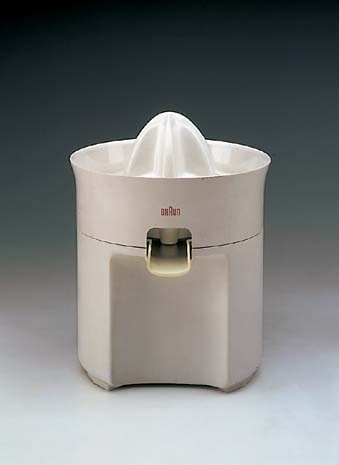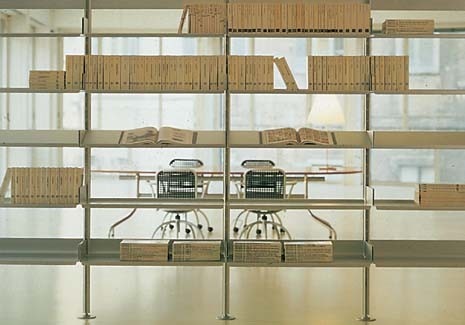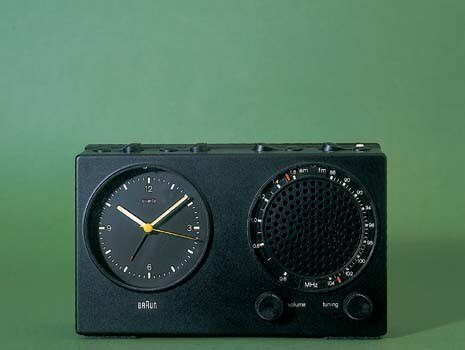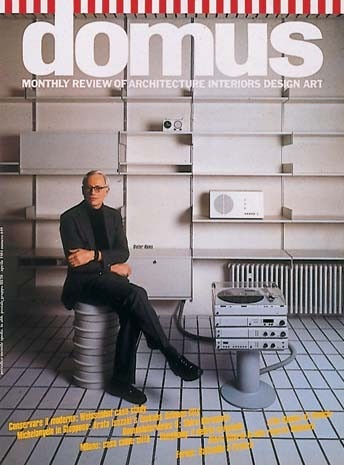Dieter Rams is 70 years old this year. But with his thick, cropped white hair, he looks exactly as he did 30 years ago in his heyday at Braun, blinking at the world through thick Euclidean spectacles like an overgrown schoolboy. Rams has been a reassuringly constant presence, even as the landscape of design in which he operates has changed beyond recognition. Braun itself, from which Rams has now retired, is hardly the company it once was.
Manufacturing consumer goods of all kinds, even those that aspire to some sort of design premium, has more or less ceased in Europe. And the products that Rams used to define the modern world – his audio systems, calculators and radios – have become as technologically redundant as the abacus, the steam locomotive and the sundial. Rams defined category types, not least of which the so-called Snow White’s coffin, the record player turntable with a transparent Perspex cover. But the long-playing record vanished long ago. It’s not just that Rams’ designs look dated – in fact, they don’t – it’s that an entire category of objects has been pensioned off. Permanence is the whole point of design, according to Rams. It is meant to be beyond fashion and frivolous, arbitrary change.
With this philosophy, being left stranded by the inevitability of time, the purity of Rams’ work takes on an almost tragic quality. Indeed, there has always been a sense of pathos to Dieter Rams. It is almost as if he has too delicate a constitution to stomach the badlands beyond the control of refined design. He cannot, it seems, handle anything more demanding than black and white. He once confessed that he finds the very idea of visual disorder so distressing that he can’t go on a country walk without taking a large paper bag with him to pick up the rubbish he finds along the way.
Rams’ old office in Braun’s headquarters, in an industrial suburb on the edge of Frankfurt, was a retreat from the chaos outside, a study in neutrality, the Switzerland of the design world. It was the kind of room in which a single fingerprint on the wall or paper out of place would have the impact of a klaxon going off in the reading room of the British Museum. Rams designed everything in it: the furniture, the products on the shelves, the clock, the radio, the stereo system. He was even responsible for the building itself. And in the whole place, the only splash of colour came from the orange packet of cigarettes that were permanently in Rams’ hands.
With the help of a roomful of assistants in matching Boris Karloff tunics and centre partings, protected by locked doors and security guards, Rams’ team designed products for Braun that were reticent to the point of being invisible. ‘They should be there ready to perform effortlessly well when they are needed, but keep out of the way without imposing when they are not, just like an English butler’, as he once famously put it. It’s not surprising, then, that the postmodernists saw Rams as the centre of some kind of puritanical modernist plot to inflict their essentially Calvinist view of design on an unwilling world.
Braun wasn’t just Rams.
The HT 1 toaster, an essential step in the creation of the Braun vocabulary, was designed by Reinhold Weiss in 1961 (and inspired the artist Richard Hamilton to embark on a series of tributes to Braun). And there was Rams’ original mentor, Hans Gugelot, based at that time at the Ulm Hochschule, along with Max Bill. But it was Rams who has come to be seen as the embodiment of a certain moment in Braun’s history. With Rams, Braun elevated the electric razor to the status of a work of art. The Micron Universal was carved from satisfyingly heavy steel with a vaguely surgical feel. Teams of Braun scientists spent years working out how to coat its lissom, brushed metal body with black rubber dots, a feat more difficult than you might imagine.
The ostensible explanation for all this effort was the quest to provide the shaver with a better grip. In fact, of course, the point was to allow Braun to deploy simultaneously two of the most effective lures in the designer’s repertoire. The Micron boasted not just the obvious glitter of chrome, but also the once attractive idea of matt black. Braun promoted it with a remarkable television commercial that cut back and forth between close-ups of the business end of the shaver, ploughing its way through the mountainous landscape of the chin, and a black Porsche 911, negotiating thickets of stubble.
Superficially, the message it was meant to put across was that this shaver was faster and more surefooted than those of the competition. But what the commercial was really doing was making a parallel between two different types of cult object: the Micron and the Porsche. Intriguingly, Rams himself used to drive just such a Porsche, a little out of character, one might think, for so steadfastly serious a designer. Rams and other latter-day functionalists, such as Ferdinand Porsche himself, tell you that they have no style, just a rational approach.
Yet when you examine the real reasons that prompt people to buy the products they design, their motivations are seldom as high minded as designers would like to think. Braun’s famous ET 22 calculator seduced an entire generation of design victims. It was a toy, but one convincing enough to be taken seriously. Even though it was far from being the best product for the money, Braun made it the distillation of a particular attitude toward the world.
Rams now works mainly for Vitsoe, the company that has manufactured Rams’ storage systems and furniture for more than 30 years. Vitsoe itself has been transformed, too. Once a German company, it is now British-owned and manufactures in the U.K. The designs look the same, but Rams persists in refining the products, using new materials and altering details but remaining true to the original spirit. And it is in this way that Rams can claim to be continuingly modern.





